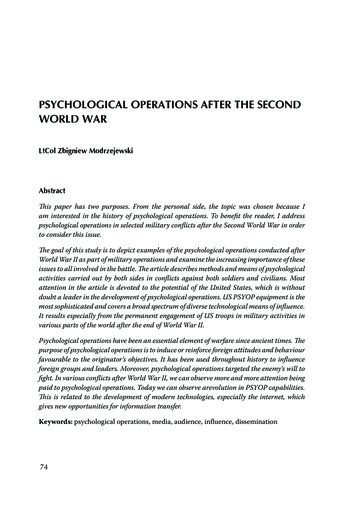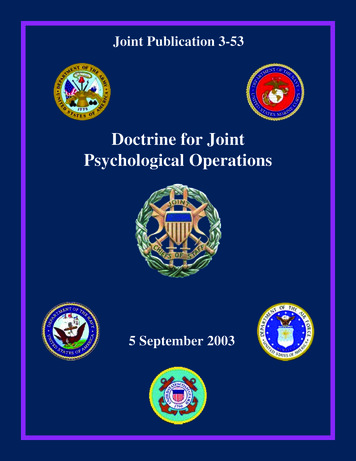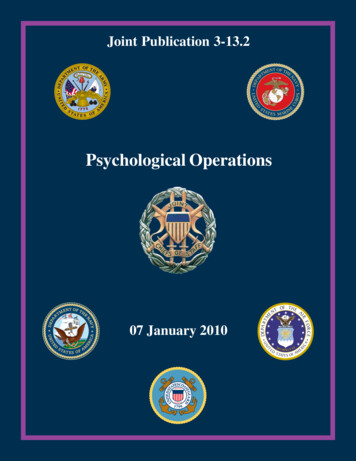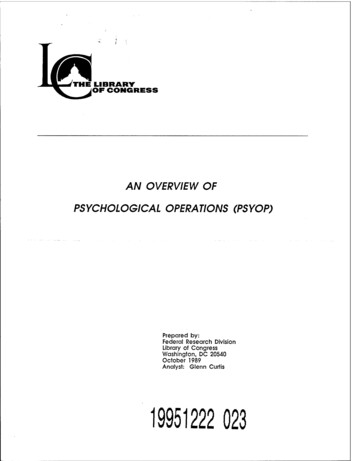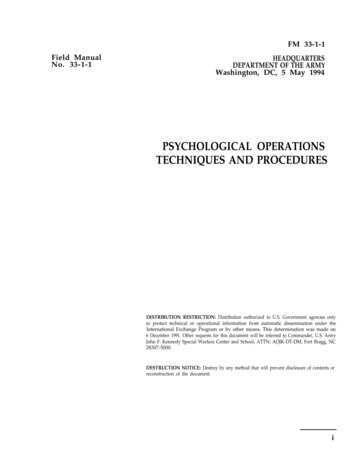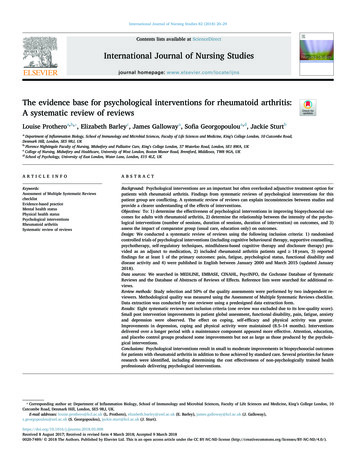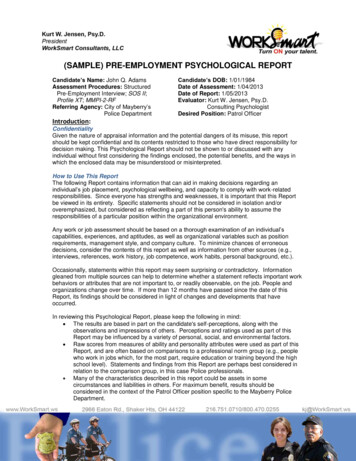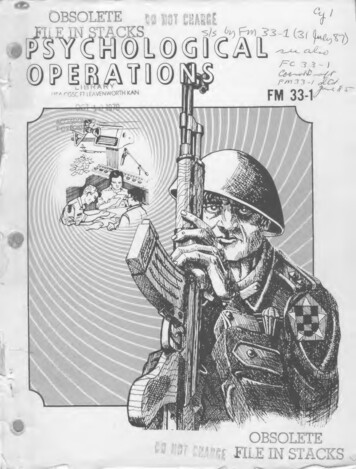
Transcription
OBSOLETE s) w) Frt] 53-1 (3 ( (L0ucm 7) * c)y F/Y) 33 -/ c C/FM 33-1 “ "OBSOLjETESSI FILE IN STACKS
FM 33-1FieldManualHEADQUARTERSDEPARTMENT OF THE ARMYWashington, DC, 31 August 1979No. 33-1PSYCHOLOGICAL OPERATIONSCONTENTSPART ONE ———PSYCHOLOGICAL OPERATIONSAND THE COMBAT -1PSYOP RESPONSIBILITIES OF THE ARMY.2-1PSYOP RELATIONSHIP WITH COMMAND AND STAFFFUNCTIONS.3-1METHODS OF EMPLOYMENT.4-1PSYOP IN SUPPORT OF FOREIGN INTERNAL DEFENSE.5-1PSYOP IN SUPPORT OF UNCONVENTIONAL WARFARE.6-1PSYOP IN SUPPORT OF SPECIAL OPERATIONS.7-1PSYOP IN SUPPORT OF PRISONER-OF-WAR AND CIVILIANINTERNEE PROGRAMS.8-1This FM supersedes FM 33-1,4 February 1971, and FM 33-5, 30 January 1974.
FM 33-1PART TWO —————PSYCHOLOGICAL OPERATIONS FOR THE 5.16.17.18.PAGEBEHAVIOR FACTORS.9-1COMMUNICATING.10-1PROPAGANDA AND COUNTERPROPAGANDA.11-1PSYOP PLANNING.12-1CONCEPT OF EMPLOYMENT.13-1INTELLIGENCE FOR PSYOP.14-1THE PSYOP AUTOMATED MANAGEMENT INFORMATIONSYSTEM .15-1PROPAGANDA COMMUNICATION.17-1PRINTED MATERIAL.18-1- NCES.A-1DETAILED BREAKDOWN OF TEAMS.B-1FORMAT FOR BASIC PSYOP STUDY (BPS).C-1FORMAT FOR PSYOP ESTIMATE OF THE SITUATION.D-1FORMAT FOR PSYOP ANNEX/APPENDIX.E-1EXPLANATION OF TARGET ANALYSIS WORKSHEET.F-1EXPLANATION OF PSYOP CAMPAIGN CONTROL SHEET.G-1PSYOP BASIC TERMS.H-1PSYOP TECHNIQUES.1-1GRAPHICS, MUSIC, AND SOUND EFFECTS REGISTERGUIDES.J-1
FM 33-1FOREWORDPsychological factors are an integral part of all battlefields. Each unit movement and everyconquest of terrain psychologically affect the battlefield participants and an audience of friendly,neutral, or hostile groups. The psychological effect of combat actions can be seen in theheightened morale of a successful unit or in the discouragement and fear of a defeated unit.Properly manipulated attitudes can modify the behavior and the combat effectiveness of thesoldier and the unit.This manual provides information and guidance for the conduct of psychological operations(PSYOP) in general, limited, and cold war. The doctrine, techniques, and procedures found hereinare applicable to conventional warfare, unconventional warfare (UW), and foreign internaldefense (FID) operations. This manual should be used in conjunction with other official manualsand publications that provide staff organization procedures and guidance for doctrine, fieldoperations, and maintenance of equipment.This manual is divided into two parts:Part One is an easy-to-read, ready reference for the combat commander and tells whatpsychological operations can do and how they can be used to achieve a quicker victory,conserve valuable resources, and save the lives of US and friendly personnel.Part Two is for the PSYOP commander, unit, and staff personnel and others with aninterest in or need for the details of psychological operations.Definitions of PSYOP basic terms are in appendix H.hi
Users of this manual are encouraged to submit comments and to recommend changesfor its improvement. Comments/recommendations should be keyed to the specificpage and line of text and be fully explained. Forward your comments to theCommandant, US Army Institute for Military Assistance, ATTN: ATSU-TD-TS,Fort Bragg, NC 28307.IVThe use of the pronouns "he,” "his,” "himself," etc., in this manual includes bothmasculine and feminine genders. Any exception to this will be so noted.
FM 33-1PARTONEPSYCHOLOGICAL OPERATIONSAND THECOMBAT COMMANDERPart One-i
FM 33-1CU&fUeA. (D te.INTRODUCTIONPsychological operations used for the purpose of creating a favorable image,gaining adherents, and undermining opponents have become a major weapon of20th century warfare.CONTENTSPAGEBackground.1-2Major PSYOP Efforts Since World War II.1-2PSYOP Today.1-3PSYOP responsibilities.1-3The Armed Services.1-3Joint Chiefs of Staff.1-3Department of the Army.1-3Department of the Navy.1-4Other Support.1-4United States Information Agency. 1-5Internal Communications Agency. 1-5
FM 33-1BACKGROUNDMAJOR PSYOP EFFORTS SINCE WORLD WAR IISince World War II, the major PSYOP effort of the United States has been bv the f Statc (STATE); subsequently, the United States Information Agency(USIA) which included the Voice of America (VOA); and now the InternationalCommunication Agency (ICA) which replaced USIADuring the Korean conflict, organization and techniques for tactical PSYOP improved.In the Vietnam action, much PSYOP activity was initiated, emphasized, and refined.The Joint United States Public Affairs Office (JUSPAO) was created by the NationalppvnpV C,0u.nc" .(NSC) in 1965 to centralize PSYOP policy and insure control ofactivities in Vietnam. Formed at the counselor level in the Embassy, this jointoffice included representatives from civilian and military US Government agencies In/ucic?n*u0 Cn A9 out the normal mission of the United States Information Service(USIS), the JUSPAO provided PSYOP policy and direction to the US and Free WorldAssistance Forces in the Republic of Vietnam (RVN).To insure unity of effort. PSYOP plans of the United States and Vietnam werecoordinated at the national level (US Embassy and Government of Vietnam)coordinating committees were also formed at the region and province level.As the result of the adoption of a central manager concept (centralized guidance anddecentralized execution), all policy stemmed from one source--JUSPAO at theEmbassy--with operational discretion permitted at lower levels of command1-2
FM 33-1Technical advances which increased the PSYOP potential included:Standardized propaganda developed by JUSPAO was available to tactical units by airdelivery to major distribution points.Printing facilities out of country produced mass printings of leaflets and newspapers.Master catalogs of themes were distributed. (Upon request, these themes were made intoleaflets.)Television was first used as an instrument of strategic propaganda.A small adapter named "Early Word” made it possible for airborne transmission of PSYOPappeals directly through an aircraft-mounted loudspeaker system. A radio signal receivedby the aircraft could be simultaneously taped in the aircraft for further replay.Tactical limitations depended only on the range of the ground transmitter and the enemy airdefense system.Support to tactical operations was modernized. Loudspeaker support was readily available toground commanders who could easily adapt themes to their particular situation (i.e., search anddestroy operations, among others).PSYOP TODAYToday US Army Reserve (USAR) PSYOP units furnish PSYOP support and expertise to theactive army. Several Army commands have established mutual support agreements withspecific USAR units to augment active army units for combat.PSYOP RESPONSIBILITIESTHE ARMED SERVICESEach of the military services provides forces to accomplish its assigned PSYOP mission.Although the US Army has the principal US military PSYOP capability, other services cansupport the PSYOP efforts. Coordination among all military services and governmentagencies is required to insure unity of effort, uniformity of policy, and adequacy of coverage.JOINT CHIEFS OF STAFF (JCS)The Joint Chiefs of Staff serve as advisers and military staff in the operational chain ofcommand for unified and specified commands. They provide a channel of communicationsfor the President and Secretary of Defense to unified and specified commands, andcoordinate all communications in matters of joint interest addressed to these commands.Under this authority, US Army PSYOP forces assigned to theater army or corps in times ofcrises or during a state of hostilities are placed under operational control or in support of thecommander of the unified command. Through the JCS or the unified command, US ArmyPSYOP units may be tasked to assist other US military or civilian agencies.DEPARTMENT OF THE ARMYDepartment of the Army develops PSYOP resources to support general, limited, cold war,and foreign internal defense. In DA, the Deputy Chief of Staff for Military Operations1-3
FM 33-1(DCSOPS) has staff responsibility for PSYOP. US Army PSYOP resources include commandand staff personnel, units, advisers, and equipment. The flow of PSYOP policy from theChief Executive to the US Army elements is depicted in figure 1-1.DEPARTMENT OF THE NAVYAlthough the Department of the Navy does not have forces dedicated to PSYOP, it cansupport psychological operations with conventional forces and equipment.OTHER SUPPORTOther government and private agencies can assist and cooperate in PSYOP activities,particularly during foreign internal defense operations. Private organizations engaged ineducation, health, disaster relief, cultural, and missionary work can be of great assistance.FIGURE 1-1PSYCHOLOGICAL OPERATIONS POLICY FLOW1-4
FM 33-1UNITED STATES INFORMATION AGENCY (USIA)In 1953 the USIA was established as an independent arm of the Government's ExecutiveBranch, and most of the functions previously vested in the Secretary of State weretransferred to the Director, USIA. Later acts expanded the duties and responsibilities ofUSIA. Title V, Section 501, Public Law 402, designated the USIA as the agency responsiblefor the preparation and dissemination abroad of information about the United States, itspeople and its policies, through press, publications, radio, motion pictures, and otherinformation centers and instructors abroad. Thus, the USIA was the foreign informationarm of the US Government, particularly in time of peace. As a part of its mission, the USIAaimed to:Promote understanding, acceptance, and respect among foreign audiences for theUnited States and its policies.Advise the President, his representatives abroad, and the various departments andagencies of government on public attitudes in other countries and their implicationson the formulation and execution of foreign policy.INTERNATIONAL COMMUNICATIONS AGENCY (ICA)On 1 April 1978, the International Communications Agency was established. Itconsolidates the functions of the United States Information Agency and the StateDepartment's Bureau of Education and Cultural Affairs. The core management of ICAconsists of a Director, a Deputy Director, and four Associate Directors, with designatedresponsibilities for broadcasting (VOA), programs (PGM), educational and cultural affairs(ECA), and management (MGT).The internal structure of the Voice of America remains essentially unchanged, but theelevation of the VOA Director gives recognition to the importance of the broadcastingservice and is intended to preserve the integrity of its news operation.The operations of the two other media elements--Press and Publications, and MotionPictures and Television--come under the direction of the Associate Director of Programs.International exhibits, which have been shown principally in the Soviet Union and EasternEurope, are a separate element in the same division.In the new structure for educational and cultural exchange, a major objective is to provideclear lines of responsibility for enhancing, on the one hand, foreign access to Americanexperiences and, on the other hand, American access to foreign experiences and culture.Aside from the White House, ICA's relationships are primarily with the Departments ofState and Defense and the Agency for International Development:It acts in an advisory capacity toward STATE, and in turn, receives foreign policyguidance.It works closely with DOD, particularly with the Offices of the Secretary for PublicAffairs and of International Security Affairs. By agreement, ICA and DOD exchangeliaison personnel at the national level and at joint commands. ICA advises on theimpact of overseas public statement and actions in the defense field and cooperatesdirectly with DOD in Washington and major commands abroad to increase support forUS policies.The Agency for International Development, under the supervision and guidance ofSTATE, administers economic aid abroad. ICA supports the AID mission by publicizingAID programs and accomplishments. Conversely, AID accomplishments reinforce ICAefforts.1-5
FM 33-1CUafUeA, Iwo.PSYOP RESPONSIBILITIESOF THE ARMYPsychological operations derive their major effectiveness from being an integralpart of a total operation. They are neither a substitute for power nor a panaceaWhen skillfully and closely integrated with actions and other instruments ofpower, PSYOP act as a catalyst and can often make the difference betweensuccess and failure in military operations. Psychological operations can beeffectively employed throughout the entire spectrum of conflict.CONTENTS PAGEThe Army PSYOP Role.2-2The Army PSYOP Mission.2-3Limited War.2-3General War.2-3Purpose of PSYOP.2-4Principles of Employment.2-4Offensive Operations.2-4Defensive Operations.2-5Retrograde Operations.2-5Relief Operations.2-6Support of Other Types of TacticalOperations.2-6Civil Affairs.2-6Types of PSYOP Support.2-6Strategic Support.2-7Tactical Support.2-7Consolidation Support.2-72-1
FM 33-1CONTENTSPAGEPSYOP in Support of Strategic Operations.2-7Major Objectives.2-8Other Objectives.2-8Conditions That May be Exploited.2-9Media.2 9PSYOP m Support of Tactical Operations.2-9Corps Support.2-10Division Support.2-10PSYOP in Support of Joint Task Force (JTF) Operations. . 2-13The JTF PSYOP Staff Officer.2 14The PSYOP Staff Officer and the J2/J3Operations Center.2-14PSYOP in Support of Consolidation Operations.2-14Organization. . . . 2-15Specific Considerations. 2-15Operational Support.2-15PSYOP Assistance.2-16Orientation and Reeducation.2-17Other PSYOP Objectives in Consolidation Operations.2 17Obstacles. .2 18Propaganda in Consolidation Operations.2 19PSYOP in Support of Rear Area Security.2 20THE ARMY PSYOP ROLEWithin DOD, the Army--because of its established psychological operations trainingbase, assigned missions, and land-based operations--has the primary military role inPSYOP. As the service with the principal assets, the Army has the major role inassisting commanders of joint task forces and unified, specified, and combinedcommands to achieve PSYOP objectives.The Army develops PSYOP resources to operate in general, limited, and cold war Inthe field PSYOP elements are responsible for:Planning and conducting PSYOP in support of military operations.Developing in all Army personnel an appreciation of the role and value of PSYOPand an understanding of the psychological implications of military operations.Planning and conducting PSYOP to support US national objectives abroad.Interallied PSYOP policy is determined at the highest levels of government andcommand. At combined levels, PSYOP may be guided by standardization agreements;e g , NATO. Where operational control of designated US Army PSYOP forces istransferred to allied commanders, directives governing the use of US PSYOP forcesand equipment will be provided to the appropriate commanders.Psychological operations are conducted by military forces under the operationalcontrol of the theater or unified command The Army PSYOP element is commandedby the theater Army commander PSYOP support may be initiated by PSYOP units ineither CONUS or at an in-theater site, normally outside of the combat zone.Operations may be conducted concurrently from both areas. When initiated inCONUS, the theater commander provides input for the development of appropriateprograms.2 2
FM 33-1The Army PSYOP mission is to support US national policy; to conduct PSYOP in support ofmilitary operations; to be prepared to conduct PSYOP unilaterally in support of, or in coordinationwith, other military services and US Government agencies; and to give PSYOP training, advice,and assistance to US forces and friendly nations.Specifically, Army PSYOP forces:Assist in formulating PSYOP doctrine, tactics, techniques, and operations of Army forces,other US military services, unified commands, and other US Government agencies. .Develop Active Army and Reserve Component (RC) forces to support plans and operationsof Army forces, other US military services, unified commands, and other US Governmentagencies.Undertake research and development programs to further the Army's capabilities forPSYOP.Furnish PSYOP-qualified personnel for liaison and military training teams (MTTs).Must be prepared to conduct these operations unilaterally in support of, or in coordinationwith, other military services and US Government agencies.Must be prepared to provide equipment and area-oriented, language-qualified PSYOPpersonnel to train, advise, and assist allied/friendly nations in developing their PSYOPcapabilities; and must be prepared to provide PSYOP assistance in support of the operationsof a host country.Provide information and generate intelligence for PSYOP.Develop, procure, issue, and stockpile PSYOP materiel and equipment; must be prepared toprovide logistical support to US Government agencies and allied/friendly nations.Conduct PSYOP training for members of all branches of the US Armed Forces andpersonnel from friendly/allied nations on a mission basis.LIMITED WARLimited war, with its complex and unwritten national policy objectives, is merely an activecontinuum of cold war. PSYOP, therefore, require a continuation of policy and executionwith a broadening of psychological objectives.The International Communication Agency (ICA) country plan and theater military plansmust be coordinated under the guidance of the US Ambassador; and the psychologicaloperator, the policy advisor, planner, and executor, must have an "up-to-the-minute”knowledge of these plans.GENERAL WARIf cold or limited war progresses to general war, the US Army PSYOP elements may berequired to increase their PSYOP activities. This may include use of organic equipment andfacilities to replace damaged or destroyed civilian mass communications equipment andfacilities.The role of US Army PSYOP in general war is established by National Security Council(NSC) directives channeled through the Department of Defense to the Department of theArmy. The role is further defined and coordinated by interagency agreements.2-3
FM 33-1The purpose of all psychological operations is to create in foreign groups the emotions, attitudes,or behavior to support the achievement of national objectives. In this endeavor, PSYOP influencepolicy, decisions, the ability to govern, the ability to command, the will to fight, the will to obey,and the will to support.Psychological operations can increase the relative combat power of friendly forces and adverselyaffect the combat power of the enemy. This is accomplished, basically, by attacking the identifiedweaknesses of the opposing forces through a planned and coordinated PSYOP campaign.PSYOP field teams are placed in direct support (DS) of the maneuver elements and travelwith them to exploit opportunities as they arise. The forward teams provide a constant flowof information to the PSYOP command element at the higher headquarters. The PSYOP unitconstantly updates the PSYOP estimate, keeps the commander informed of thepsychological impact of the operation, and makes recommendations for the conduct ofcombat operations.As the attack progresses, the bypassed, isolated enemy elements are targeted by the fieldteams. The field teams use all available media to induce their surrender, thereby conservingthe combat resources of the attacking force.Tactical deception plans are supported by using misleading sound effects and bydisseminating misinformation. During this time PSYOP support can enable the maneuvercommander to concentrate his maneuver units while giving the appearance of maintainingnormal dispersion. Operations, such as the feint or ruse, are primarily psychological sincethe intent is to confuse the enemy and have him react in a desired manner.Planners, operators, and intelligence personnel require access to all available intelligence thatpertains to their mission and area of operations. Effective reporting channels are necessary toinsure that the flow of information reaches the PSYOP unit on a timely, uninterrupted basis.Ei lPL0Yf lE§lTOffensive OperationsThe mission, enemy, terrain, weather, populace, and availability of troopsinfluence PSYOP support.PSYOP effectively support combat power.Under certain conditions, offensive operations are conducted for theirpsychological impact.PSYOP exploit the effects of friendly nuclear fires.PSYOP increase the psychological impact of conventional operations.2-4
FM 33-1PSYOP support subordinate units by facilitating exploitation of targets ofopportunity.PSYOP are coordinated with higher and adjacent units when the effects areexpected to influence enemy actions outside of the unit's boundaries.PSYOP are coordinated with the tactical fire support elements in the operationalarea to enhance the effectiveness of both systems.PSYOP support tactical deception operations and other facets of the OPSECprogram.Defensive OperationsPSYOP units supporting combat units in the defense continue to maintain a PSYOPoffensive. The defensive situation provides an excellent opportunity to establishcredibility by factual news reporting. PSYOP missions in support of the defenseinclude those required to:Prepare to resume the offense.Discourage an enemy offensive.Support forces delaying an enemy advance.Support the planning and conduct of counterattacks.Support rear area protection operations.Conduct PSYOP against bypassed and isolated enemy units in rear areas.Support tactical deception operations and other facets of the OPSEC program.Retrograde OperationsRetrograde operations are characterized by limited offensive, defensive, and delayingtactics. PSYOP teams with heavy printing, broadcasting, and other relatively immobileequipment positioned well to the rear are able to provide uninterrupted support.PSYOP are able to support retrograde operations by:Publicizing civilian control measures.Supporting tactical deception operations and other facets of the OPSECprogram.Exploiting the psychological effects of nuclear and nonnuclear firepower.Supporting counterattacks by placing emphasis on the large number of enemycasualties.Relief OperationsPSYOP will:Support tactical operations and other facets of the OPSEC program.Remain in place to support the incoming unit.During a forward passage of the lines, support the attacking unit.During a rearward passage of the lines, remain with the covering forces.2-5
FM 33-1Support of Other Types of Tactical OperationsWhen supporting other types of tactical operations, the basic PSYOP principles apply;however, the techniques and manner of application may vary.Civil AffairsPSYOP support civil affairs in offensive, defensive, retrograde, relief, and consolida tion operations.FIGURE 2-1PSYOP SUPPORT OF A THEATERTYPES OF PSYOP SUPPORTPsychological operations support is type-classified according to the level of employment,location, and the physical scope of the operation. The classifications overlap.There are no clearcut lines as to where support stops for one type operation and begins for another. A PSYOP unitmay support all types of operations simultaneously. The three major classifications are:2-6
FM 33-1STRATEGIC SUPPORTPsychological operations in support of strategic operationsare designed to exploit vulnerabilities in foreign militaryforces and populations. They are designed to advancebroad or long-term objectives. General support (GS)forces are generally used in this role.TACTICAL SUPPORTPsychological operations in support of tactical operationsare planned and conducted in the combat area to achieveimmediate and short-term objectives. Normally, directsupport (DS) PSYOP units are used.CONSOLIDATION SUPPORTPSYOP supporting consolidation operations assist in thereorientation and education of the civilian population inliberated or occupied areas. The purpose is to facilitatemilitary operations and obtain maximum cooperation ofthe inhabitants.PSYOP IN SUPPORT OF STRATEGIC OPERATIONSPsychological operations in support of strategic operations are directed at large segments of thetarget nation's population. These psychological operations exploit economic, military,sociological, psychological, and political vulnerabilities. They are an integral part of the overallstrategic scheme.PSYOP policies and objectives are approved at the national level. Effective interagencycoordination is established at all levels of government and command to insure that no conflictsexist between military PSYOP and other government activities.Guidance for the support of strategic operations usually emanates from the National CommandAuthority (NCA). Psychological operatons are coordinated with general strategic plans and aredirected against forces, people, or areas in their entirety.Psychological operations supporting strategic operations are normally conducted in support ofthe unified or specified commands. The unified command issues directives to implement thenational policy and establish command policy. These operations are not limited to the area ofinfluence of individual subordinate commanders.Planning is a continuing process. PSYOP personnel continually evaluate the results of currentoperations, update current plans, and continue long-range planning to insure adequate supportfor future operations. Contingency plans and supporting pretested propaganda are prepared andheld ready for implementation on order. It is during the planning phase that the psychologicalimpact of a contemplated course of action must be considered. (See chapter 12, PsychologicalOperations Planning, for more detailed information.)2-7
FM 33-1MAJOR OBJECTIVESDeter enemy forces from initiating hostilities or intervening in existing conflicts.Create concern in the enemy concerning the futility of war.Arouse public concern, political, and economic pressures for or against a militaryoperation.Stimulate dissension among enemy rival power groups.OTHER OBJECTIVESProject a favorable image of the United States.Foster understanding and gain acceptance of US goals and operations.Convince the target that the United States can fulfill its aspirations.Explain US policies and objectives to allied, friendly, and neutral nations.Strengthen determination of friends and allies.Build confidence of allies in the objectives of the alliance.Gain support of neutrals.Support resistance personnel.Gain support in liberated areas.Strengthen friendly leaders; weaken enemy leaders.Influence enemy strategy and tactics:Identify and exploit enemy weaknesses.Develop modifications in the character and policies of the enemy to favor theUnited States.Stress enemy racial and religious intolerance.Publicize and exploit enemy, racial, ethnic, and religious prejudices and intolerance.Build or create enemy political disunity.Stimulate support of opposition elements of the enemy.* Undermine confidence in enemy leadership and war aims.* Interfere with control systems and communications.Support and foster economic and other nonviolent sanctions against the enemymilitary forces and civilians.Encourage disaffection in enemy nations among religious, ethnic, social, political,economic, and other elements.Support tactical operations.2-8
FM 33-1CONDITIONS THAT MAY BE EXPLOITEDMilitary successes of friendly forces.Shortages of food, housing, clothing, or other necessities in enemy territory orenemy-occupied areas.Enemy manpower shortages.Enemy country inflation.Unequal and exorbitant taxation by the enemy government.Lack of resources to support the enemy economy and war programs.Enemy police state practices to include terrorism, midnight arrests, travelrestrictions, and censorship.MEDIAThe most desirable media for strategic operations are radio, television, and leaflets.PSYOP IN SUPPORT OF TACTICAL OPERATIONSPsychological operations are an integral and coordinated part of the overall tactical plan. Theyprovide the tactical commander with an additional weapons system, a system that can weakenthe enemy soldier's will to fight, thereby reducing his combat effectiveness, and that can preventcivilian interference with military operations. They are designed to exploit individual and groupsusceptibilities.Psychological operations in support of tactical operations are planned and executed for specificoperations. Targets of opportunity are exploited as they arise.The theater Army commander, in addition to providing resources to the theater commander toconduct PSYOP in support of theater plans, provides PSYOP resources to support tacticalcommanders, civil affairs operations, and rear area protection.CORPS SUPPORTThe PSYOP resources available at corps include staff officers and direct support unitsrequired to plan, develop, and execute psychological operations. The corps PSYOP staffofficer, with his knowledge of the tactical operations, may be called on to provide specificrecommendations to be included in theater plans.Each corps is normally supported by a direct support battalion. The divisions, separatebrigades, and regiments are normally supported by a direct support company from the corpsdirect support battalion. When limited PSYOP units are available, the combat elements maybe supported by specific teams tailored to fit the mission.2-9
FM 33-1DIVISION SUPPORTThe direct support mission of PSYOP units is to provide close, continuous, and prioritysupport to the division and its maneuver elements; these units remain under the centralizedcontrol of the higher PSYOP commander.The division is supported by a direct support PSYOP company consisting of a command andcontrol team (AA); command assessment (AD); supply and maintenance (BA); propagandadevelopment (FA); current intelligence (FC); light printing (GA); platoon headquarters, audioand visual (HA); loudspeakers (HB); and an audiovisual team (HC).Support During Movement to ContactDuring movement into a hostile area, the AD team deploys into a hostile area andanalyzes
Aug 31, 1979 · This manual provides information and guidance for the conduct of psychological operations (PSYOP) in general, limited, and cold war. The doctrine, techniques, and procedures found herein are applicable to conventional warfare, unconventional warfare
